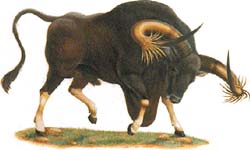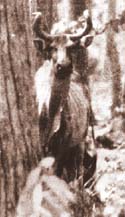Kouprey, Cambodian Forest Ox
The Kouprey, also called the Cambodian Forest Ox is one of the most mysterious animals alive today.
It was unseen and unheard of until late 1937, and since then has been seen a bare handful of times by scientists.
The Kouprey is a greyish colored forest oxen, with frayed looking horns and a long dewlap of skin hanging from its neck.

The Kouprey is a rare forest ox
When the Kouprey is about three years of age, the horns split, and seem to fray, growing like this for the rest of their lives.
Scientists think this is so they can be used to dig into the ground and thrust into tree stumps.
The Kouprey live in the lower rolling hills, where they dwell in the patchy dry forests that are found near the denser monsoon type forestation, and live in herds.
About twenty family members gather together grazing in the open areas in daylight hours, and move to the forests to shelter from sunshine and the predators in the area.
A Kouprey ranges from North Cambodia to the eastern areas, and has also been seen in Thailand, southern Laos, and western Vietnam.
This species has proven themselves to be incredibly elusive, and many efforts and expeditions to find and photograph it end up with viewings that happen so fast they are unable to be pictured.
Much of the information that is available on it comes from a full fledged field study of the species, conducted over two months in the 1950s by Charles Wharton, who did manage somehow to film it.
 Prince Sihanouk designated it as the national animal of Cambodia in the 1960s, partly due to its mystery and elusive behavior.
Prince Sihanouk designated it as the national animal of Cambodia in the 1960s, partly due to its mystery and elusive behavior.
It is said also that it could be one of the most valuable animals genetically in the entire world, due to clues it may hold to disease resistance and its uncanny ability to survive in extremely harsh conditions.
The kouprey has always been rare.
Due to the destruction of its habitat from agriculture, logging, and warfare, along with hunting and disease, it has in fact become even more rare.
There were at one time concerns in the mid seventies that it might have become extinct, however this was proven untrue, when it was seen in several locations.
Though the animal has not been seen since about 1999, its tracks and skulls have been spotted, and show that some koupreys do exist — though probably only about 150 to 300 of them.




I note that the writer states Kouprey last seen in 1999.
Where? Was this a properly documented sighting?
The horns and skulls and tracks that are seen…where? When? And again , are these properly documented and verified?
I would LOVE to believe the Kouprey still exists, but real proof is needed to reinforce that belief!